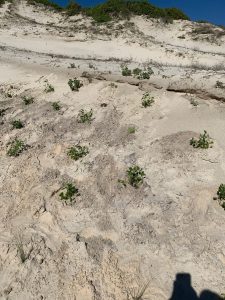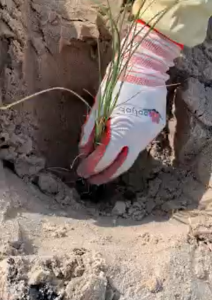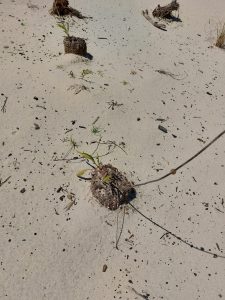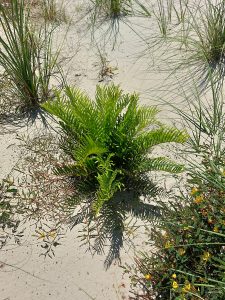Background Information
Little NaNa Dune is located in a particularly historical and geographically significant place in Florida, American Beach. This is an important area for African American heritage in north Florida. It contains many significant buildings with beautiful homes and outdoor spaces. Burney Park is next to NaNa Dune – a beautiful ecosystem along the coastline of the Atlantic Ocean. NaNa Dune is the tallest dune in Florida!
NaNa Dune and Little NaNa Dune are separate tracts of land with different owners directly across from each other. Together they encompass about 9.55 acres. Both areas serve as important habitat for native plants and wildlife including gopher tortoises and migratory/nesting birds. NaNa Dune was purchased by the National Park Service, who maintains it as conservation land. Read more about NaNa Dune at American Beach Museum on Amelia Island. Little NaNa Dune was purchased by North Florida Land Trust, who worked with Dune Science Group to plant and restore it in 2022. It is located on the other side of Ocean Blvd toward the southeastern tip of the bigger NaNa dune. See below:
NaNa Dune
Size: 8.5 acres
Location: American Beach, Nassau County, FL
(Pictured below bordered in red). Photo: Nassau County Property Appraiser
Little NaNa Dune
Size: 1.55 acres
Location: American Beach, Nassau County, FL. Across the street from NaNa Dune, near the southern tip of Ocean Blvd and contains 3 parcels now in conservation (Pictured below bordered in red).Top photo from Nassau County Property Appraiser, bottom photo (drone image) from North Florida Land Trust.
Restoration of Little NaNa Dune
Over the years, sand continues to erode from the face of Little NaNa dune which been damaged from wind. The dune needs a stable sediment profile where roots can develop to produce strong and healthy plants. This will sustain and supports wildlife. Some sections of the dune lacked any plant cover whatsoever, leading to unproductive, damaged, “blown-out” areas as sand blew away. The goal of the dune restoration needed to include holding the sand in place.
This goal was achieved by planting native beach plants where the area had eroded. Dune restoration projects should consult the Florida Department of Environmental Protection CCCL Dune Planting Recommendations.
Plant material
Nearly 5,000 native dune plants were put in the ground on April 7th and April 8th, 2022 including many native beach plants of northeast Florida. All plants are on FDEP’s Recommended Florida Native Beach and Dune Plants. Click each plant to learn more.
Preventing wilt before planting
Although we planted Little NaNa Dune in April 2022, when the weather was much cooler than peak of summer; the salt spray, warm wind and afternoon heat still caused many plants to transpire the water faster than we could water them, resulting in wilt. This highlights the importance of ensuring planting holes are pre-dug and pre-watered, if possible. In addition to retaining your planting stock, this will also help the plants become established in the project area sooner.
Since the restoration plants tend to be in small containers (3-5″ pots to 1/2 gallon containers on the bigger plants) preventing desiccation of the root system is paramount. It is advised to work in small sections and keep plants together near a water source. The plants will need to be watered several times during the project period.
Initial planting (April 2022)
The North Florida Lant Trust team and volunteers from the Fernandina Beach Sea Oat Lovers, Amelia Island Comp Plan/LDC Working Group, and UF/IFAS Extension Nassau County along with other community members completed the initial planting over two days. Frank Hopf from the Dune Science Group provided expertise and guided the team of volunteers. Photos by David Hébert





Two years after planting (May 2024)
The photos below were taken about 2 years after initial planting by David Hébert.


(A) (B)



Read more articles about Little NaNa Dune below:
Little NaNa Dune – North Florida Land Trust (nflt.org)
 0
0


